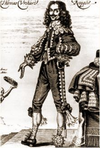List of unusual deaths in the early modern period
Appearance
| Lists of unusual deaths | ||
|---|---|---|
| Antiquity | ||
| Middle Ages | Renaissance | Early modern period |
| 19th century | 20th century | 21st century |
| Animal deaths | ||
This list of unusual deaths includes unique or extremely rare circumstances of death recorded throughout the early modern period, noted as being unusual by multiple sources.
-
The suicide of François Vatel
-
The death of Georg Wilhelm Richmann, killed by ball lightning
-
John Day's submarine
Early modern period
[edit]| Name of person | Image | Date of death | Details |
|---|---|---|---|
| Sir Francis Bacon |  |
9 April 1626 | The English philosopher and statesman died of pneumonia after stuffing a chicken carcass with snow to learn whether it could preserve meat.[1][2][unreliable source?] |
| Jörg Jenatsch |  |
24 January 1639 | The Swiss political leader was assassinated by a person dressed in a bear costume wielding an axe. Legend states that the axe was the same one that Jenatsch had once used to kill a rival.[3][4] |
| Sir Arthur Aston | September 1649 | During the Siege of Drogheda, the Cavalier commander from Reading, England, was beaten to death by Oliver Cromwell's army with his own wooden leg because they suspected gold coins were concealed inside.[5][failed verification][6] | |
| Thomas Urquhart |  |
1660 | The Scottish aristocrat, polymath, and first translator of François Rabelais's writings into English is said to have died laughing upon hearing that Charles II had taken the throne.[2][unreliable source?][7][8] |
| François Vatel |  |
24 April 1671 | The majordomo of Prince Louis II de Bourbon-Condè was responsible for a banquet for 2,000 people hosted in honour of King Louis XIV at the Château de Chantilly, where he died. According to a letter by Madame de Sévigné, Vatel was so distraught about the lateness of the seafood delivery and about other mishaps, that he committed suicide with his sword, and his body was discovered when someone came to tell him of the arrival of the fish.[9][10] |
| Molière |  |
17 February 1673 | The French playwright suffered a pulmonary hemorrhage caused by tuberculosis while playing the part of a hypochondriac in his own play Le malade imaginaire. He disguised his convulsion as part of his performance and finished out the show, which ends with his character dead in a chair. After the show, he was carried in the chair to his house, where he died.[2][unreliable source?][11][12] |
| Jean-Baptiste Lully |  |
22 March 1687 | The French composer died of a gangrenous abscess after accidentally piercing his foot with a staff while he was vigorously conducting a Te Deum. It was customary at that time to conduct by banging a staff on the floor. He refused to have his leg amputated so he could still dance.[13][14] |
| William III of England |  |
8 March 1702 | The king of England was riding his horse when it stumbled on a molehill. William fell and broke his collarbone, then contracted pneumonia and died several days later. After he died, Jacobites were said to have toasted in the mole's honour, calling it "the little gentleman in the black velvet waistcoat".[15][16] |
| Hannah Twynnoy |  |
23 October 1703 | The 33-year-old barmaid at the White Lion Inn was mauled to death by a tiger in Malmesbury, Wiltshire. She was the first person to be killed by a tiger in British history.[17][18][19] |
| Frederick, Prince of Wales |  |
31 March 1751 | The son of George II of Great Britain and father of George III died of a pulmonary embolism, but was commonly claimed to have been killed by being struck by a cricket ball.[20]: 105 [21] |
| Professor Georg Wilhelm Richmann |  |
6 August 1753 | The Russian physicist was killed when a globe of ball lightning which he created in his laboratory struck him in the forehead.[22][23] |
| Henry Hall | 8 December 1755 | The 94-year-old British lighthouse keeper died several days after fighting a fire at Rudyerd's Tower, during which molten lead from the roof fell down his throat. His autopsy revealed that "the diaphragmatic upper mouth of the stomach greatly inflamed and ulcerated, and the tuncia in the lower part of the stomach burnt; and from the great cavity of it took out a great piece of lead ... which weighed exactly seven ounces, five drachms and eighteen grains". The piece of lead is currently in the collection of the National Museum of Scotland.[24][25][26] | |
| John Day | 20 June 1774 | The English carpenter and wheelwright was the first human known to have died in an accident with a submarine. Day submerged himself in Plymouth Sound in a wooden diving chamber attached to a sloop named the Maria and never resurfaced.[27][28] | |
| Frantisek Kotzwara |  |
2 September 1791 | While in London, the 31-year-old Czech violinist visited a prostitute named Susannah Hill and requested his neck be tied with a noose around a door knob. He died after the sexual intercourse of erotic asphyxiation.[29][30] |
| Samuel Spencer | 20 March 1793 | The North Carolina lawyer and former colonel was sleeping on a porch in Anson County while wearing a red cap. Spencer's bobbling head drew the attention of a turkey, which viewed Spencer as another turkey and fatally wounded the 59-year-old with its talons.[31][32][note 1] |
Notes
[edit]- ^ This source incorrectly gives Spencer's age at death as 60.
References
[edit]- ^ Paoletti, Gabe (31 July 2019) [Originally published 13 November 2017]. Kuroski, John (ed.). "The Strange Deaths Of 16 Historic And Famous Figures". All That's Interesting. Retrieved 8 August 2024.
Many of history's most important figures have suffered strange deaths that do not seem to befit their noble legacy.
- ^ a b c Wallace, Lorna (13 March 2023). "13 Authors Whose Deaths Were Stranger Than Fiction". Mental Floss. Retrieved 1 September 2024.
- ^ "The world's most unusual assassinations". World. BBC News. 16 February 2017. Retrieved 19 October 2024.
- ^ Ritchie, Gayle (26 November 2020). "Assassins' Deeds: Booby-trapped statue in Mearns cottage killed Scottish king". The Courier. Retrieved 19 October 2024.
John's book details a host of weird assassination methods. Another strange one is the story of a Swiss leader Jörg Jenatsch...
- ^ Gardiner, Samuel Rawson (1894). History of the Commonwealth and Protectorate, 1649–1660. Vol. 1. London; New York: Longsmans, Green, and Co. – via Internet Archive.
- ^ Fort, Hugh (26 July 2020). "The bizarre tale of loathsome Reading soldier beaten to death with his own wooden leg". Reading. BerkshireLive. Retrieved 17 October 2024.
...In a cruel ending, he was beaten to death with his own wooden leg.
- ^ Irving, David (1861). Caryle, John Aitken (ed.). The History of Scottish Poetry. Edinburgh: Edmonston & Douglas. p. 539 – via Internet Archive.
Sir Thomas Urquhart, another poet, is said to have expired in a paroxysm of laughter, on hearing of the restoration of Charles the Second; a statement which is rendered sufficiently probable by the record of similar cases, and by the eccentric character of the individual.
- ^ Stock, Elliot (1891). The Bookworm: An Illustrated Treasury of Old-time Literature. Vol. 4. New York: A.C. Armstrong & Son. p. 152 – via Google Books.
There is a curious tradition that Sir Thomas Urquhart died of an inordinate fit of laughter on hearing of the restoration of Charles II.
- ^ Abad, Reynald (2002). "Aux origines du suicide de Vatel : les difficultés de l'approvisionnement en marée au temps de Louis XIV" [At the origins of Vatel's suicide: the difficulties of tidal supply at the time of Louis XIV]. Dix-Septième Siècle (in French). 217 (4): 631–641. doi:10.3917/dss.024.0631.
Alors que le côté spectaculaire du geste de Vatel le transformait, à partir du XIXe siècle, en une sorte de fait d'arme de l'histoire culinaire de la France, son côté disproportionné en faisait parallèlement un objet d'étonnement et même de mystère.
[While the spectacular side of Vatel's gesture transformed it, from the 19th century onwards, into a sort of feat of arms in the culinary history of France, its disproportionate side at the same time made it an object of astonishment and even mystery.] - ^ Elhassan, Khalid (4 July 2018). "10 Historical Deaths Weirder Than the Movies". History Collection. Retrieved 6 September 2024.
- ^ Evans, Mary (18 January 2001). "Mysterious Molière". The Economist. Retrieved 7 October 2024.
Among the considerable number of men dedicated to the task of keeping Louis XIV entertained, several met bizarre ends... Nothing, however, quite equals the death of Jean-Baptiste Poquelin, the self-styled sieur de Molière...
- ^ Walsh, Kieran (2016). "38: The Characters (in Silhouette) from Molière's Play Le malade imaginaire". Medical Education: A History in 100 Images. Boca Raton, Florida: CRC Press. pp. 83–84. ISBN 978-1-4987-5197-1 – via Google Books.
Ironically Molière collapsed on stage while playing the hypochondriac in Le malade imaginaire.
- ^ Schonberg, Harold C. (13 September 1970). "Then There Was Lully, Put a Baton in His Foot". The New York Times. p. 23. Retrieved 7 October 2024.
Oddball deaths? Perhaps the only really freakish one concerning a composer involved Jean‐Baptiste Lully, the favorite of the Sun King.
- ^ Lekkas, Demetrios E. (Spring 2019). "The true "punching bag" behind Molière's The Middle-Class Nobleman". Epistēmēs Metron Logos (2): 11–39. doi:10.12681/eml.20569 – via EJournals.
...I do wonder whether this is in reference to the ultimately fatal bâton / baston, that is the long conducting stick of the orchestra director, which, in the dominant current version regarding historical fact, would ultimately, years later, turn out to be responsible for Lully's death, in a notorious tragic freak accident...
- ^ Hand, Bill (3 June 2018). "A look at William of Orange, one of state's earliest kings". New Bern Sun Journal. Retrieved 8 October 2024.
His death was a little unusual: his horse threw him when it stumbled in a mole's burrow and the king broke his collarbone.
- ^ "The five most bizarre deaths of English monarchs". Portals to the Past. 5 August 2021. Archived from the original on 12 August 2021. Retrieved 27 August 2024.
- ^ Beckford, Martin (24 September 2007). "BBC reveals Britain's most unusual epitaphs". The Telegraph. Retrieved 5 October 2024.
Almost as strange as Mrs Johnston's gravestone is the story of Hannah Twynnoy, whom [sic] historians believe was probably the first person in Britain to be killed by a tiger.
- ^ Thompson, Matthew (3 December 2014). "9 Strange Graves from Around the World". Bizarre. The Lineup. Retrieved 5 October 2024.
Hannah Twynnoy holds the bizarre title of England's first tiger fatality.
- ^ "Hannah Twynnoy". Athelstan Museum Malmesbury. Retrieved 19 October 2024.
Three centuries have passed since the shocking death of a young woman in Malmesbury, yet Hannah Twynnoy is remembered here in Malmesbury each day.
- ^ Marvin, Frederic Rowland (1900). The Last Words (Real and Traditional) of Distinguished Men and Women. Troy, New York: C. A. Brewster & Co. Retrieved 20 November 2024 – via Google Books.
To some of the most distinguished of our race death has come in the strangest possible way, and so grotesquely as to subtract greatly from the dignity of the sorrow it must certainly have occasioned.
- ^ Castelow, Ellen (27 December 2014). "Frederick Prince of Wales". Historic UK. Retrieved 19 October 2024.
But the strangest death must be that of Frederick, Prince of Wales who died, some sources claim, after being hit with a cricket-ball.
- ^ Schiffer, Michael Brian (22 March 2012) [Originally published 2003]. "An Electrical World". Draw the Lightning Down: Benjamin Franklin and Electrical Technology in the Age of Enlightenment (online ed.). Oakland, California: University of California Press. pp. 161–183. doi:10.1525/california/9780520238022.003.0008. ISBN 978-0-520-23802-2. Retrieved 5 September 2024 – via California Scholarship Online.
Sokolow was destined to become the only witness to that day's bizarre events.
- ^ Gupton, Nancy (12 June 2017). "Benjamin Franklin and the Kite Experiment". The Franklin Institute. Retrieved 8 October 2024.
...Baltic physicist Georg Wilhelm Richmann attempted a similar trial but was killed when he was struck by ball lightning (a rare weather phenomenon).
- ^ "Barbarous experiments at Plymouth". The Zoist. 11. H. Baillière: 248. 1854 – via Google Books.
The reality of this assertion seemed, however, then incredible to Dr. Spry, who could scarcely suppose it possible that any human being could exist after receiving melted lead into the stomach...
- ^ Adams, W. H. Davenport (1870). Lighthouses and Lightships. London: T. Nelson and Sons. p. 117. ISBN 978-1-342-54487-2 – via Google Books.
Of the other two light-keepers, one, named Henry Hall, met his death in an extraordinary manner.
- ^ "12-day fight for life after accident during 1755 blaze". Somerset County Gazette. 11 July 2001. Retrieved 8 October 2024.
The story of Henry Hall became even more bizarre.
- ^ McCartney, Innes (2003). "No 1/29, Maria - World's First Submarine Death". Lost Patrols: Submarine Wrecks of the English Channel. Penzance, Cornwall: Periscope Publishing Ltd. pp. 48–49. ISBN 1-904381-04-9. Retrieved 24 October 2024 – via Google Books.
Until the wreck is located, the story remains a curious anecdote in the annals of submarine losses.
- ^ Abel, Stuart (6 June 2020). "The strange tale of the world's first submarine death in Plymouth Sound". Plymouth Sound. The Herald. Plymouth. Retrieved 24 October 2024.
- ^ Bell, Rachael (26 January 2006). "Internet Assisted Suicide: The Story of Sharon Lopatka". Crime Library. Archived from the original on 26 January 2006. Retrieved 29 August 2024.
Knud R. Joergensen wrote in 1995 about the 1791 case of composer Franz Kotzwara who enlisted the help of a London prostitute, Susannah Hill, to assist him with his bizarre wish... It was the first documented case of death by sexual strangulation.
- ^ Rayborn, Tim (2016). Beethoven's Skull: Dark, Strange, and Fascinating Tales from the World of Classical Music and Beyond. New York: Skyhorse. p. 103. ISBN 978-1-5107-1272-0 – via Google Books.
More notable is the manner of his death, which was quite shocking for the time and hints at some very dark fetishes indeed.
- ^ Copeland, J. Isaac; Cashion, Jerry C. (January 2023) [Originally published 1994]. "Spencer, Samuel". NCpedia. Retrieved 10 August 2024.
Spencer's death came as the result of an unusual accident.
- ^ Kennard, David (16 March 2024). "This Week In History". The Robesonian. Retrieved 10 August 2024.
Spencer had a most unusual death, by turkey.



